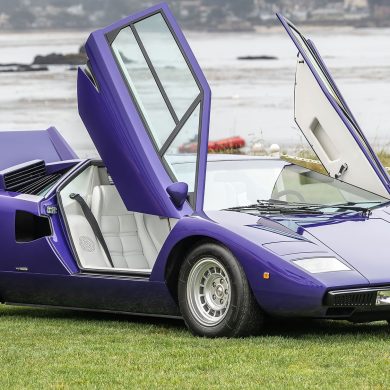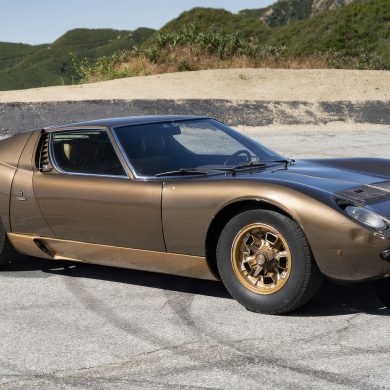The Lamborghini Aventador was first launched in March 2011 in Geneva with President and CEO of Automobili Lamborghini Stephan Winkelmann stating, “The future of our supercars has become a reality with the Aventador LP 700-4.” In honor of the supercar’s 10th birthday, we have listed ten innovative changes to the car over the last decade.
The Lamborghini Aventador’s value is not limited to its performance or the power of its naturally aspirated V12 engine. It also introduced a number of technical and technological innovations through the years with its four different versions namely, the LP 700-4, Superveloce, S, and SVJ.
[adthrive-in-post-video-player video-id=”379jXOPs” upload-date=”2021-07-01T23:43:05.000Z” name=”Lamborghini .mp4″ description=”null” player-type=”default” override-embed=”default”]
1. Carbon Fiber
The carbon-fiber monocoque of the Aventador LP 700-4 was the first for Lamborghini supercars, establishing Lamborghini as a leader in developing and producing composite materials. The Sant’Agata automaker would become the first company to create such a large quantity of carbon fiber elements in-house.

The carbon-fiber monocoque of the Lamborghini Aventador was made using a variety of patented Lamborghini technologies. It is a “single shell” monocoque that combines the vehicle cockpit, roof, and floor in a single structure, ensuring its structural rigidity. Along with the two front and rear aluminum sub-frames, it is an engineering feat that provides great structural rigidity while being exceptionally lightweight (only 229.5kg.)
The roof of the Aventador Roadster version includes two sections that is constructed entirely out of carbon fiber, which was an improvement from the soft top of the Murciélago. The innovations are not simply for better aesthetics, but also provide optimum rigidity while having a remarkably lightweight roof, with each section weighing less than 6kgs.
More carbon fiber elements were incorporated in the Superveloce version as it was also applied on the door panels and sills, remodeled in superlightweight composite materials (SCM), especially for the interiors. It was also the first time that Carbon Skin® technology was employed in a production car. It is a superlightweight material that when combined with a very specialized resin, becomes flexible, soft to the touch, and extremely wear-resistant.
2. Four-wheel Drive
The Lamborghini Aventador’s sheer power made it essential that it has a reliable transmission to give the driver the best driving experience feasible.

The electronically controlled torque distribution located between the front and rear wheels incorporates three elements: a rear self-locking differential, Haldex torque distributor, and a front differential that operates together with the ESP.
In just milliseconds, the system can adjust the torque distribution of the car’s handling conditions. 60% of the torque can also be transferred to the front axle in the most critical cases depending on the driving mode that the driver selects.
3. Suspension
The innovative Push Rod suspension system has been implemented from the very first version of the Lamborghini Aventador.
The Formula 1 inspired system features rods connected to the lower part of the hub housing of each wheel, it then “transmits the force” to the shock-absorber-spring assemblies arranged horizontally in the frame’s upper part, both at the front and rear.

In the Aventador Superveloce, the Lamborghini Push Rod suspension system then added the magnetorheological shock absorbers (MRS). These immediately respond to road conditions and driving style: adjusting the damping on each bend, greatly minimizing roll, and enabling a more responsive vehicle handling and steering—the front-end diving when braking is also minimized due to the “adaptive” suspension.
4. Independent Shifting Rod (ISR) robotized gearbox
The Aventador is also fitted with a robotized gearbox which was remarkable for a road super sports car in 2011.

The seven-speed system provides remarkably quick gear changes. The Independent Shifting Rod (ISR) gearbox contains two lightweight carbon fiber shifting rods that can simultaneously move the synchronizer: one for gear engagement and one for disengagement. The system enables Lamborghini to attain a gearshift time of only 50 milliseconds which is the same speed that the human eye moves.
5. Drive Select Modes and EGO mode
The driving style customization evolved as the Aventador also changed. Five styles of gearbox and three manual (Strada, Sport, and Corsa) were offered for the Aventador LP 700-4, along with two automatic (Strada-auto and Sport-auto).

For the Aventador Superveloce, the modes were given an increased capability to modify the driving set up, with the three Drive Select system modes (Strada, Sport, and Corsa) having the ability to adjust the transmission, engine, shock absorbers, differentials, and steering.
The Aventador S had a major evolution that enabled the driver to pick from four different modes: STRADA, SPORT, CORSA, and EGO. The additional EGO mode enables the driver to pick from a few more configuration profiles that can also be customized by picking the preferred criteria for steering, traction, and suspension that is within the range of the settings for the STRADA, SPORT, and CORSA.
6. Lamborghini Dinamica Veicolo Attiva (LDVA)
The longitudinal control on the Aventador comes from the Lamborghini Dinamica Veicolo Attiva (LDVA – Lamborghini Active Vehicle Dynamics) control unit.

This is an improved ESC strategy that was first introduced on the Aventador S, giving it faster and more precise control of traction and vehicle handling depending on the driving mode that was selected.
LDVA is like an electronic brain that obtains real-time information regarding the vehicle’s movements from the car sensors. It can then define the best set-up for all the active systems, ensuring the best handling behavior for all driving conditions.
7. Aerodinamica Lamborghini Attiva 2.0 (ALA 2.0) and LDVA 2.0
The SVJ version incorporated the Aerodinamica Lamborghini Attiva 2.0 system to improve the roadholding and performance of the Aventador. In addition, an updated second-generation LDVA system was implemented.
The patented ALA system was first seen on the Huracán Performante, with the upgraded version equipped on the Aventador SVJ. They recalibrated it to account for the greater lateral acceleration of the vehicle and, in addition, introduced a new air intake and aero channel designs.
The ALA system actively changes the aerodynamic load to either have high downforce or low drag, depending on the dynamic conditions.
In the front splitter and engine hood, electronically actuated motors open or close active flaps to help direct airflow in the front and rear sections.
8. All-Wheel Steering
The introduction of the Aventador S was the first time that an all-wheel system was introduced on a Lamborghini series car.

The set-up enables better agility at both low and medium speeds, while also providing stability at greater speeds. Along with the Lamborghini Dynamic Steering (LDS) on the front axle, it provides a more natural response as well as improved reactivity on tighter bends.
Two separate actuators monitor and react to the driver’s steering within five milliseconds, enabling real-time angle adjustments and an improvement in the balance between roadholding and traction.
When driving at low speed, the wheelbase is virtually reduced by having the rear wheels in the opposite direction of the steering angle. At high speeds, both the front and rear wheels are in the same direction as the steering, allowing for the wheelbase to be virtually increased, giving greater stability and optimizing the reactivity of the car.
9. Stop-Start System
Lamborghini has been committed to reduce pollution and consumption while simultaneously increasing efficiency since 2011.
Since the LP 700-4 model, the Lamborghini Aventador has been equipped with an innovative, rapid stop-start system with supercap to store electrical power, thereby providing a greatly reduced fuel consumption.
Lamborghini introduced state-of-the-art technology in the new Aventador stop-start system that was never before seen in the automotive industry: the supercap provides electrical power to restart the engine after stopping, giving it an extremely fast restart. In 180 milliseconds, the V12 restarts making it a lot faster than conventional stop-start systems.
10. Cylinder Deactivation System (CDS)
The Cylinder Deactivation System (CDS) is another technology that improved the efficiency of the vehicle. With a reduced load and speeds below 135kph, the CDS deactivates one of the cylinder banks allowing the engine to continue working as a straight-six engine.

Full power becomes accessible with the slightest touch of the accelerator. Both the stop-start system and the CDS work extremely fast, making it practically unnoticeable by the driver so that the driver can fully enjoy the thrill of the driving experience. Despite being unnoticeable, they do greatly improve efficiency compared to cars that are not using the technologies. The combined fuel consumption of the Aventador was minimized by 7%. At highway speeds of 130kph and above, they can reduce fuel consumption and polluting emissions by up to 20%.
[Source: Lamborghini]










